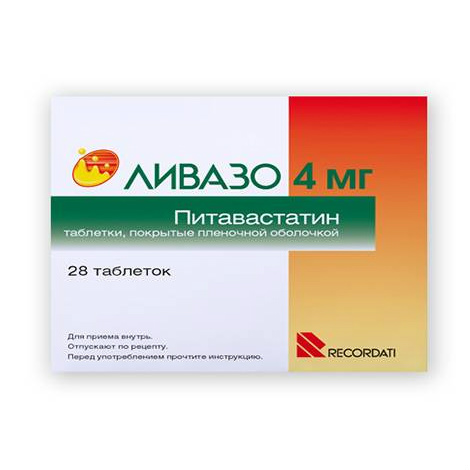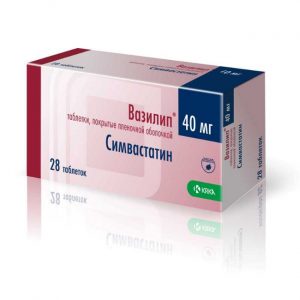Description
Pharmacological action of
Pitavastatin competitively inhibits HMG-CoA reductase, limiting the rate of action of the enzyme in the biosynthesis of cholesterol, inhibits the synthesis of cholesterol (XC) in the liver. As a result, the expression of LDL receptors in the liver is increased, contributing to the capture of circulating LDL in the blood, lowering total cholesterol and LDL cholesterol (LDL-C) in the blood. Its persistent inhibition of hepatic synthesis of Chs reduces the secretion of LDL into the blood, reducing the level of triglycerides in blood plasma.
Livazo lowers elevated LDL-C, total cholesterol and triglycerides, and increases HDL cholesterol (HDL-C). The drug reduces the level of apolipoproteins (Apo-B) and leads to a variable increase in Apo-A1.
Pharmacokinetics
Absorption
Pitavastatin is rapidly absorbed in the upper gastrointestinal tract, Cmax in plasma is reached within 1 hour after oral administration. Absorption is independent of food intake. The drug, unchanged, undergoes enterohepatic circulation and is well absorbed in the small intestine. The absolute bioavailability of pitavastatin is 51%.
Cmax of pitavastatin in blood plasma decreased by 43% with a high-fat meal, but the AUC remained unchanged.
Distribution of
Pitavastatin is more than 99% bound to plasma proteins, mainly albumin and 1-acid glucoprotein, with an average Vd of about 133 l. Pitavastatin is actively transported to hepatocytes, the site of action and metabolism, by many liver carriers, including OATP1B1 and OATP1B3. Plasma AUC varies with an approximately 4-fold range between the highest and lowest values. Research on SLCO1B1 (the gene that encodes OATP1B1) suggests that the polymorphism of this gene can explain the large fluctuation of AUC. Pitavastatin is not a substrate for P-glucoprotein.
Metabolism
Pitavastatin unchanged is the majority of the drug in plasma. The main metabolite is an inactive lactone, which is formed via the ether-type pitavastatin glucuronide conjugate with UDP glucuronosyl transferase (UGT1A3 and 2B7). In vitro studies using 13 isoforms of human cytochrome P450 (CYP) show that the metabolism of pitavastatin by CYP is minimal CYP2C9 (and to a lesser extent CYP2C8) is responsible for the metabolism of pitavastatin to minor metabolites.
Excretion
Unchanged pitavastatin is rapidly excreted from the liver into bile, but undergoes enterohepatic recirculation, which determines the duration of its action. Less than 5% of pitavastatin is excreted in the urine. T1 / 2 from blood plasma ranges from 5.7 h (1 dose) to 8.9 h (equilibrium), the geometric mean of oral clearance is 43.4 l / h after a single dose.
Indications
Primary hypercholesterolemia, including heterozygous familial hypercholesterolemia (type IIa hyperlipidemia according to the classification of Fredrickson) or mixed hypercholesterolemia (type II hyperlipidemia according to the Fredrickson classification), type IV hypertriglyceridemia, and other type II dimerdemia and hyperidemia diphenidemia non-drug methods of treatment (for example, exercise, weight loss) are insufficient.
Contraindications
Severe hepatic insufficiency (more than 9 points on the Child-Pugh scale) or class C according to the Child-Pugh classification, liver disease and active phase, including a persistent increase in the activity of hepatic transaminases in blood serum (more than 3 times compared with VGN) myopathy concomitant use of cyclosporine pregnancy, the period of breastfeeding, lack of adequate methods of contraception in women of childbearing age under 18 years of age (efficacy and safety have not been established) hypersensitivity to pitavastatin, auxiliary components of the drug and other HMG-CoA reductase inhibitors (statins).
Special instructions
Effect on
muscles Along with other HMG-CoA reductase inhibitors (statins), myalgia, myopathy, and less commonly rhabdomyolysis are also observed. Patients should be warned that they should immediately consult a doctor if any symptoms in their muscles appear. When patients develop muscle pain or muscle weakness, especially if they are accompanied by malaise or fever, creatine kinase levels must be determined.
Creatine kinase should not be measured after exercise or if there are any other possible reasons for the increase in creatine kinase, which can be confusing when interpreting the results. After detecting an increased concentration of creatine kinase (more than 5 times compared with VGN) for 5-7 days, a control analysis is required and, if necessary, stop taking the drug.
Before treatment with
, Livazo is prescribed with caution to patients with predisposing risk factors for rhabdomyolysis. In the following cases, a creatine kinase level measurement is required to establish standard baseline data: – renal failure
– decreased thyroid function
– personal or family history of hereditary muscle disorders
– previous case of muscle toxicity from fibrates or other statins
– history of liver disease or alcohol abuse
– elderly patients over 70 years old risk factors for rhabdomyolysis.
During treatment with
If severe muscle symptoms occur, therapy should be discontinued, even if creatine kinase levels are less than 5 times lower than those with VGN. If the symptoms stop, and the creatine kinase level returns to normal, then you can resume taking Livazo at a dose of 1 mg / day and with careful monitoring.
Liver effects
Livazo should be used with caution in patients with a history of liver disease or in patients who abuse alcohol. Before starting treatment with Livazo and periodically during the entire course of therapy, it is necessary to monitor liver function indicators. Treatment should be discontinued in patients with a persistent increase in plasma transaminases (ALT and AST) more than 3 times compared with VGN.
Impact on the kidneys
Livazo should be used with caution in patients with moderate or severe renal failure. Increasing the dose should be carried out only with careful monitoring of renal function after a gradual titration of the dose. A dose of 4 mg is not recommended for patients with severe renal failure.
Interstitial pulmonary disease
Interstitial pulmonary disease has been reported during the use of certain statins, especially with long-term therapy. Severe symptoms may include shortness of breath, unproductive cough, and poor general health (fatigue, weight loss, and fever). In case of suspected development of interstitial lung disease in a patient, statin therapy should be discontinued.
Influence on the ability to drive vehicles and control mechanisms
There is no data on the impact on the ability to drive a vehicle and control moving mechanisms.
Composition
Active ingredient: calcium pitavastatin, which corresponds to a pitavastatin content of 4 mg,
Excipients: lactose monohydrate, low-substituted hyprolose, hypromellose, magnesium aluminum metasilicate, magnesium stearate.
Composition of the film membrane: White opadray, including hypromellose, titanium dioxide, triethyl acetate, colloidal silicon dioxide.
Side effects
Frequency is defined as: very often ( 1/10), often ( 1/100 to <1/10), infrequently ( 1/1000 to <1/100), rarely ( 1/10 000 to <1/1000), very rarely (<1/10 000) and is unknown. Often: headache, constipation, diarrhea, indigestion, nausea, myalgia, joint pain. Infrequently: anemia, anorexia, insomnia, dizziness, dullness of taste, drowsiness, tinnitus, abdominal pain, dry mouth, vomiting, increased transaminases (AST, ALT), pruritus, rash, muscle cramps, pollakiuria, asthma , malaise, weakness, peripheral edema. Rarely: decreased visual acuity, burning mouth syndrome, acute pancreatitis, cholestatic jaundice, impaired liver function, impaired liver function, myopathy, rhabdomyolysis, urticaria, erythema. The following side effects have been identified with certain statins: sleep disturbance, including nightmares, memory loss, sexual dysfunction, depression, isolated cases of interstitial lung disease, especially with prolonged therapy. Overdose of In case of an overdose, symptoms of adverse reactions may intensify. There is no specific antidote. Symptomatic treatment and supportive measures should be taken as needed. Liver function and creatine kinase levels need to be monitored. Hemodialysis is ineffective. Storage conditions The drug should be stored in its original packaging, protected from light, out of the reach of children, at a temperature not exceeding 25 ° C. Expiration 4 years. Deystvuyuschee substances Pytavastatyn Terms of dispatch from pharmacies Prescription Formulation tablets




